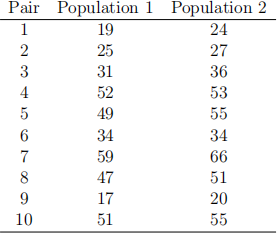STA238 (Probability, Statistics and Data Analysis II) - Winter 2023 Assignment 2
Hello, dear friend, you can consult us at any time if you have any questions, add WeChat: daixieit
STA238 (Probability, Statistics and Data Analysis II) - Winter 2023
Assignment 2
Due: Friday, March 17 at 5.00pm
Q1. Do SAT scores for high school students differ depending on the students’ intended
field of study? Fifteen students who intended to major in engineering were compared with 15 students who intended to major in language and literature. Given in the accompanying table are the means and standard deviations of the scores on the verbal and mathematics portion of the SAT for the two groups of students:

(a) Construct a 95% confidence interval for the difference in average verbal scores of students majoring in engineering and of those majoring in language/literature.
(b) Construct a 95% confidence interval for the difference in average math scores of students majoring in engineering and of those majoring in language/literature.
(c) Interpret the results obtained in parts (a) and (b).
(d) What assumptions are necessary for the methods used previously to be valid?
Q2. The braking ability of two types of automobiles was compared. Random samples of 64
automobiles were tested for each type. The recorded measurement was the distance required to stop when the brakes were applied at 40 miles per hour. The computed sample means and variances were as follows:

Do the data provide sufficient evidence to indicate a difference in the mean stopping distances of the two types of automobiles? Give the attained significance level.
Q3. The state of California is working very hard to ensure that all elementary age students
whose native language is not English become proficient in English by the sixth grade. Their progress is monitored each year using California English Language Development test. The results for two school districts in southern California for the 2003 school year are given in the accompanying table? Do the data indicate a significant difference in the 2003 proportions of students who are fluent in English for the two districts? Use α = .01.

Q4. Children’s recall and recognition of television advertisements was studied in the Jour-
nal of Advertising (Spring 2006). Two groups of children were shown a 60-second commercial for Sunkist FunFruit Rock-n-Roll Shapes. One group (the A/V group) was shown the ad with both audio and video; the second group (the video-only group) was shown only the video portion of the commercial. Following the viewing, the chil- dren were asked to recall 10 specific items from the ad. The number of items recalled correctly by each child is summarized in the accompanying table. The researchers theorized that “children who receive an audiovisual presentation will have the same level of mean recall of ad information as those who receive only the visual aspects of the ad.”

(a) Set up the appropriate null and alternative hypotheses to test the researchers’ theory.
(b) Find the value of the test statistic.
(c) Give the rejection region for α = 0.10.
(d) Make the appropriate inference. What can you say about the researchers’ theory?
(e) The researchers reported the p-value of the test as p-value = .62. Interpret this result.
(f) What conditions are required for the inference to be valid?
Q5. The data for a random sample of 10 paired observations are shown in the following table.

(a) If you wish to test whether these data are sufficient to indicate that the mean for population 2 is larger than that for population 1, what are the appropriate null and alternative hypotheses? Define any symbols you use.
(b) Conduct the test from part (a), using α = 0.10. What is your decision?
(c) Find a 90% confidence interval for µd . Interpret this interval.
(d) What assumptions are necessary to ensure the validity of the preceding analysis?
Q6. Suppose that Y1 , Y2 , · · · , Yn constitute a random sample from the density function

where θ is an unknown, positive constant.
(a) Find an estimator θˆ1 for θ by the method of moments.
(b) Find an estimator θˆ2 for θ by the method of maximum likelihood.
(c) Adjust θˆ1 and θˆ2 so that they are unbiased. Find the efficiency of the adjusted θˆ1 relative to the adjusted θˆ2 .
2023-03-07